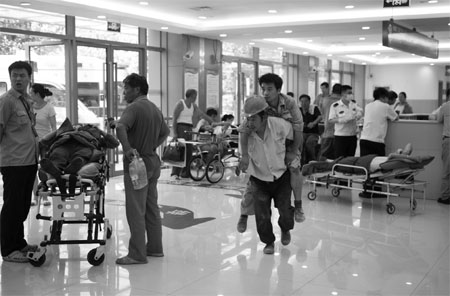Private hospitals need help
|
A scene at the Shanghai No 6 People's Hospital. Gao Erqiang / China Daily |
Providing 10 percent of nation's beds, treating 43 percent of agencies
Although the Chinese government vows to make private hospitals competent medical providers, they remain weak compared with the public ones.
In Shanghai, there were 170 public and 147 private hospitals by the end of 2012. Clinics in villages, towns and counties are mostly state operated. Only in the field of small specialist out-patient clinics, do private clinics outnumber their public counterparts - 1,458 to 391, according to the Shanghai municipal government.
Private hospitals and clinics only account for 10 percent of the national total of sickbeds, although they treat 43 percent of the national medical agencies. But there is still a long way to go for private hospitals to become competent competitors with the public ones and win people's recognition.
Diagnosis and treatment costs are much cheaper at the crowded public hospitals than private hospitals, while medicines are more expensive. The doctors and nurses are markedly underpaid, because of government control. They have no choice but to prescribe certain medicines for kickbacks, and taking small amounts of gift money from patients.
China's reform of its medical system needs to not only fix the distorted medicine sales system, which fattens middlemen, but also to promote the healthy growth of private hospitals to compete with the public hospitals.
But there are obstacles to overcome to help private hospitals.
The planned economy instilled an entrenched concept in people's minds, including officials of public health administrations, that state-run hospitals provide the best medical care, and are the place for most to depart from the world.
Commercial medical insurance is less developed because people overwhelmingly rely on the government medical-insurance system, which integrates well with the national public hospitals.
Restrictions on the free flow of human talent also hinder the growth of private hospitals. Most good doctors work at public hospitals. The medical authority's symbolic permission of allowing doctors to work for different hospitals does not make a difference because the rule is that doctors must obtain the approval of their first employer before going elsewhere.
It is much easier for doctors to apply for higher professional ranks and become medical administration officials in public hospitals, which have close relations with medical authorities at various levels, than in private hospitals.
The government needs to remove policy controls on the non-profit private medical agencies, investment in and financing of private hospitals, and ease their tax burdens.
Current rules stipulate that investors do not own the organizations they invest in if the organizations are registered as non-profit in the civil affair departments.
The non-profit medical agencies are collectively owned by their working staff, but not the investors. The ownership issue explains why most private medical agencies are non-profit in China.
The government sets the minimum investment threshold for joint-venture hospitals at 20 million yuan ($3.28 million). That high minimum requirement means the government only encourages big foreign investors to set up large hospitals in China. But the country needs private hospitals of various sizes to meet the demands from villages to megacities.
The China (Shanghai) Pilot Free Trade Zone, a national-level showcase initiative to explore new policies in finance, trade, service sectors and governance, maintains the 20 million yuan requirement in its new supportive policies.
Application and registration procedures of setting up a private hospital differ from place to place in certain medical fields, and are very complicated. There are strict software and hardware requirements for private hospitals.
Although the government says that public and private hospitals are equal in terms of medical -care technology, some key technology can only be used in hospitals of certain rank.
There is not yet a rank-evaluation system for private hospitals in many places, making the technological equality in official's discourses only exist on paper.
Private hospitals, regarded by the government as partially public-interest organizations, cannot be mortgaged to raise funds. The tax for private hospitals is much heavier than public counterparts, and it is much more expensive for private hospitals to buy medical equipment from abroad.
The central government sends out clear signals that local governments should encourage the development of private hospitals and foreign investment in the field. But some key supportive files of the central authority are vaguely worded and do not set a deadline for changes.
The State Council issued a file as early as 2010 to "gradually abolish the restrictions on foreign capital's equity share to promote the development of private hospitals". But the spirit of that effort has not yielded the desired results.
Such files of principles and directions leave considerable room for local authorities to compromise the implementation, or slight over their responsibilities as grassroots reformers.
Last month, the State Council gave private hospitals the authority to set prices for their diagnosis and treatment, which had been controlled by the government.
This is another good beginning to improve private hospitals' competitiveness. They can pay the doctors more, and save the patients more money from expensive drugs.
But analysts still hold a wait-and-see attitude toward how local governments will put this decision-making authority into practice.
To translate the central government's support into the healthy expansion of private hospitals, there should be coordinated efforts by authorities in various sectors to simplify procedures for setting up private hospitals.
liyangi@chinadaily.com.cn



















